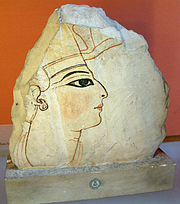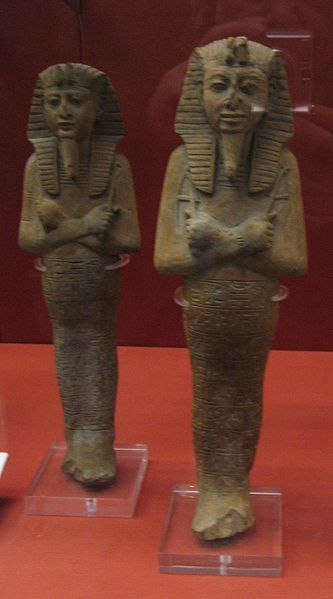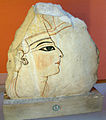Ramsés VI
Nebmaatra-Meriamón Ramsés-Amonhirjopshef-Necherheqaiunu, o Ramsés VI, reinó de 1143 a 1136 a. C.,[1] y fue el quinto gobernante de la dinastía XX de Egipto.
Contenido
Biografía [editar]
Ramsés VI tomó el trono en una época en que la monarquía era débil política y económicamente, siendo faraón casi solamente de nombre.
Usurpó el trono de su sobrino, Ramsés V, también los cartuchos de reyes anteriores y mandó grabar su nombre en la lista de reyes en Medinet Habu para legitimar su reinado y realzar su autoridad.
Según la reconstrucción que realizó Raphael Ventura del Papiro de Turín 1907-1908, se sabe que Ramsés VI reinó ocho años y dos meses, y que le sucede su hijo Ramsés VII.
Testimonios de su época [editar]
Edificaciones
Mandó edificar y realizar obras en templos de varias regiones:
- Edificó un templo en Heliópolis
- Un pilono y varias obras en Menfis
- Varias obras en Karnak
Estatuas de Ramsés VI
Ordenó colocar estatuas suyas en muchas ciudades. Se han encontrado:
Otras referencias
- Tiene una estela en Karnak
- Es mencionado en una inscripción cerca de Sehel
- Hay fragmentos inscritos en el Sinaí
La tumba de Ramsés VI
Su tumba está en el Valle de los Reyes, KV9, que usurpó a su sobrino Ramsés V, agrandándola posteriormente. Está cercana a la de Tutanjamón. Poco tiempo después de su entierro, su tumba fue saqueada por ladrones que destrozaron su cuerpo para robarle las joyas.
Titulatura [editar]
| Titulatura | Jeroglífico | Transliteración (transcripción) - traducción - (procedencia) |
| Nombre de Horus: |
| k3 nḫt ˁ3 nḫtu s ˁnḫ t3uy (Kanenajtu Sanjtauy) Toro protente, Grande en la victoria, por el que reviven las Dos Tierras (Egipto) |
| Nombre de Nebty: |
| urs ḫps hd hnfu (Userjepeshedhefnu) De potente golpe, que vence multitudes |
| Nombre de Hor-Nub: |
| usr rnput my t3 tnn (Userenputmitatenen) Potente y duradero como Tantenen |
| Nombre de Nesut-Bity: |
| nb m3ˁt rˁ mr imn (Nebmaatra Meriamón) Señor de la justicia (Maat) de Ra, amado de Amón |
| Nombre de Sa-Ra: |
| rˁ ms su imn nṯr hk3 iunu (Ramsés Amonhirjopshef Necherheqaiunu) Engendrado por Ra, potente como Amón, Señor de Heliópolis |
Notas [editar]
- ↑ Cronología según Shaw y Málek.
Enlaces externos [editar]
 Wikimedia Commons alberga contenido multimedia sobre Ramsés VI. Commons
Wikimedia Commons alberga contenido multimedia sobre Ramsés VI. Commons
| Predecesor: Ramsés V | Faraón Dinastía XX | Sucesor: Ramsés VII |
Ramesses VI
From Wikipedia, the free encyclopedia
| Ramesses VI[1] | |||||
|---|---|---|---|---|---|
| Also written Ramses and Rameses | |||||
 | |||||
| Image of Ramesses VI on display at the Louvre | |||||
| Pharaoh of Egypt | |||||
| Reign | 1145–1137 BC, 20th Dynasty | ||||
| Predecessor | Ramesses V | ||||
| Successor | Ramesses VII | ||||
| Consort(s) | Nubkhesbed | ||||
| Children | Ramesses VII, Iset or Isis, Amonherkhopsef, Panebenkemyt | ||||
| Father | Ramesses III | ||||
| Mother | Iset Ta-Hemdjert | ||||
| Died | 1137 BC | ||||
| Burial | KV9 | ||||
Ramesses VI (also written Ramses and Rameses) was the fifth ruler of the Twentieth dynasty of Egypt who reigned from 1145 BC to 1137 BC and a son of Ramesses III by Iset Ta-Hemdjert. His royal tomb, KV9, is located near Tutankhamun's tomb in the Valley of the Kings.
Ramesses' prenomen or royal name was Nebmaatre-meryamun meaning "Lord of Justice is Re, Beloved of Amun" while his royal epithet—Amunherkhepshef Netjer-heqa-iunu—translates as "Amun is his Strength, God Ruler of Heliopolis.[2] His 8th Regnal Year is attested in a graffito which names the then serving High Priest of Amun, Ramessessnakht. Based on Raphael Ventura's successful reconstruction of Turin Papyrus 1907+1908, Ramesses VI is now known to have enjoyed a reign of 8 full Years.[3][4] He lived for two months into his brief 9th Regnal Year before dying and was succeeded by his son, Ramesses VII.
[edit] Reign
Egypt's political and economic decline continued unabated during Ramesses VI's reign; he is the last king of Egypt's New Kingdom whose name is attested in the Sinai.[5] At Thebes, the power of the chief priests of Amun Ramessesnakht grew at the expense of Pharaoh despite the fact that Isis, Ramesses VI's daughter, was connected to the Amun priesthood "in her role as God's Wife of Amun or Divine Adoratice."[6]
Shortly after his burial, his tomb was penetrated and ransacked by grave robbers who hacked away at his hands and feet in order to gain access to his jewelry. A medical examination of his mummy which was found in KV35 in 1898 reveals severe damage to his body with this pharaoh's head and torso being broken into several pieces by an axe.[4] This damage was caused by tomb robbers who were robbing the dead king's body of his jewelry. The creation of Ramesses VI's tomb, however, protected Tutankhamon's own intact tomb from grave robbers since debris from its formation was dumped over the tomb entrance to the boy king's tomb.
[edit] References
- ^ [1] Ramesses VI Nebmaatre-meryamun
- ^ Peter Clayton, Chronicle of the Pharaohs, Thames & Hudson Ltd, (1994), p.167
- ^ Raphael Ventura, More Chronological Evidence from Turin Papyrus Cat.1907+1908, JNES 42, No.4 (1983), pp.271-277
- ^ a b Clayton, p.168
- ^ Nicolas Grimal, A History of Ancient Egypt, (Blackwell Books: 1992), p.288
- ^ Grimal, p.288
- Nos ancêtres de l'Antiquité, 1991, Christian Settipani, p. 169, 171 and 173
[edit] External links
| This article about Egyptology or subjects relating to Ancient Egypt is a stub. You can help Wikipedia by expanding it. |
Category:Ramses VI
From Wikimedia Commons, the free media repository
Media in category "Ramses VI"
The following 15 files are in this category, out of 15 total.









![N35 [n] n](http://es.wikipedia.org/w/extensions/wikihiero/img/hiero_N35.png)


![X1 [t] t](http://es.wikipedia.org/w/extensions/wikihiero/img/hiero_X1.png)


![S29 [s] s](http://es.wikipedia.org/w/extensions/wikihiero/img/hiero_S29.png)



![F12 [wsr] wsr](http://es.wikipedia.org/w/extensions/wikihiero/img/hiero_F12.png)













![V30 [nb] nb](http://es.wikipedia.org/w/extensions/wikihiero/img/hiero_V30.png)

![M17 [i] i](http://es.wikipedia.org/w/extensions/wikihiero/img/hiero_M17.png)
![Y5 [mn] mn](http://es.wikipedia.org/w/extensions/wikihiero/img/hiero_Y5.png)












![V30 [nb] nb](http://en.wikipedia.org/w/extensions/wikihiero/img/hiero_V30.png)

![M17 [i] i](http://en.wikipedia.org/w/extensions/wikihiero/img/hiero_M17.png)
![Y5 [mn] mn](http://en.wikipedia.org/w/extensions/wikihiero/img/hiero_Y5.png)
![N35 [n] n](http://en.wikipedia.org/w/extensions/wikihiero/img/hiero_N35.png)

















![X1 [t] t](http://en.wikipedia.org/w/extensions/wikihiero/img/hiero_X1.png)

![S29 [s] s](http://en.wikipedia.org/w/extensions/wikihiero/img/hiero_S29.png)



![F12 [wsr] wsr](http://en.wikipedia.org/w/extensions/wikihiero/img/hiero_F12.png)

























No hay comentarios:
Publicar un comentario